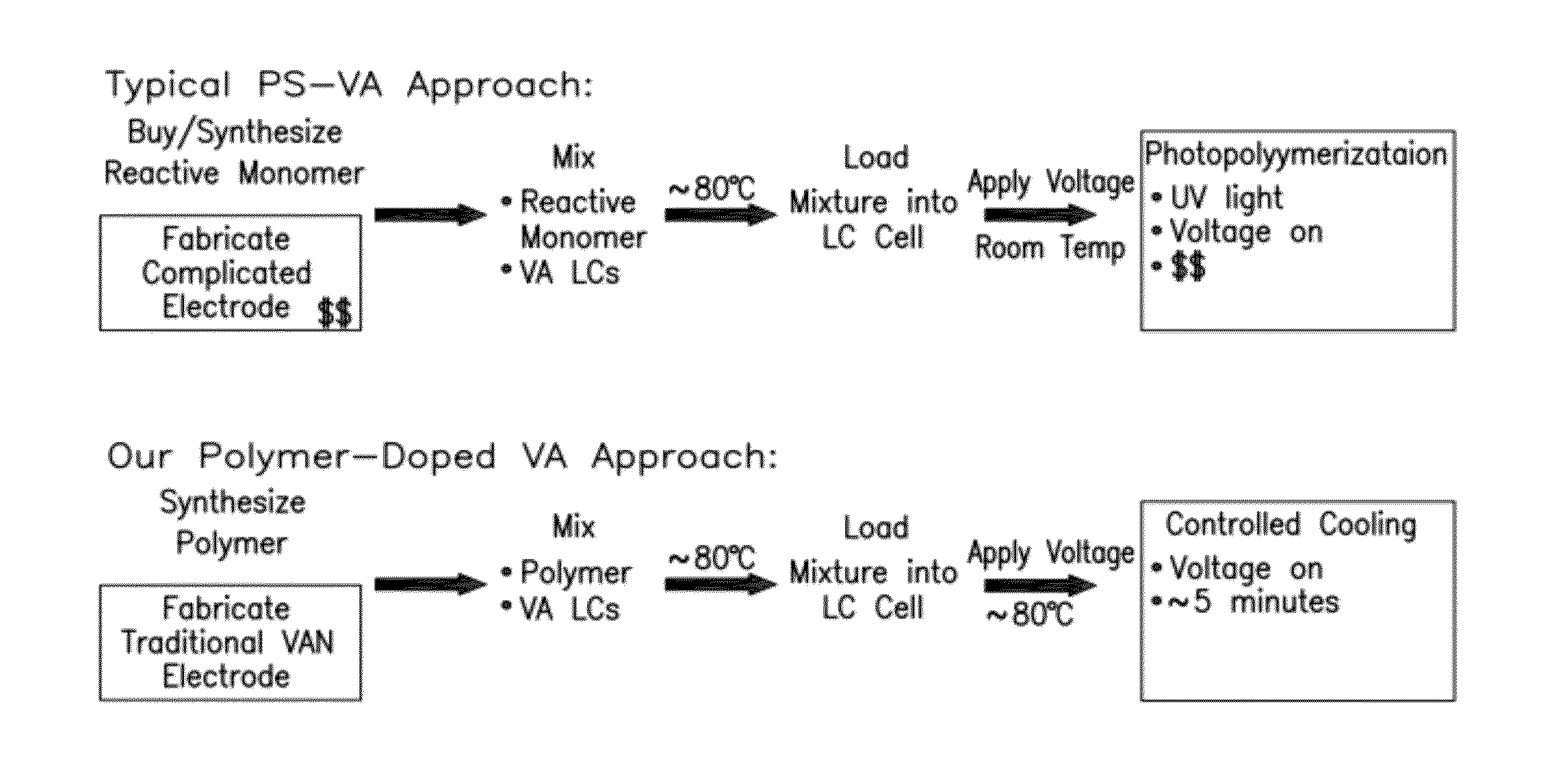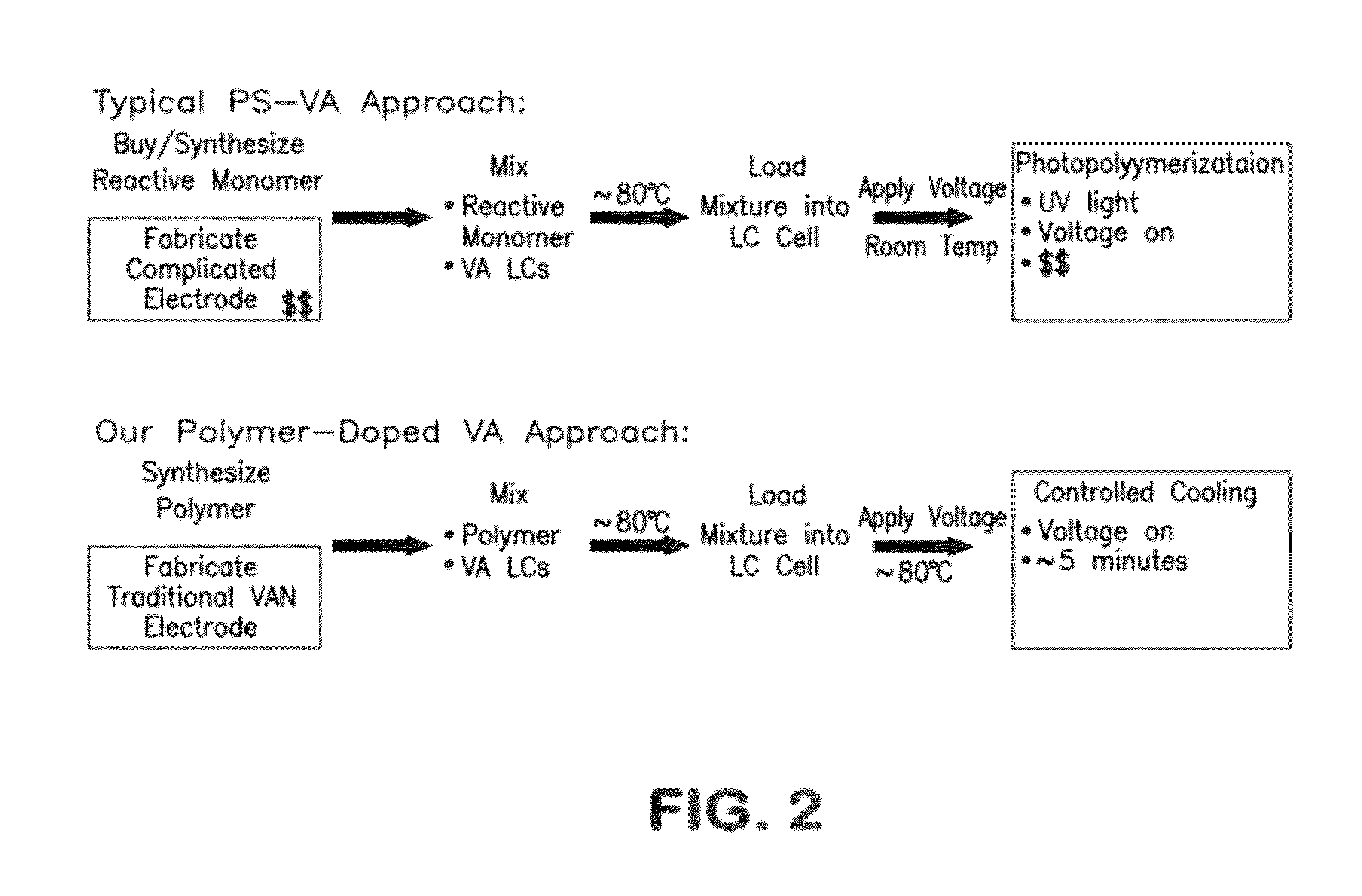[0007]Provided is a technology that significantly improves both the
processing and device characteristics of vertically aligned nematic liquid
crystal systems. The
system described here generally uses polymers synthesized and purified outside of the display that are added at low concentration to the nematic liquid
crystal that makes up the
active medium of the LCD. The material comprising a small concentration of polymer dissolved in a liquid
crystal is referred to as a polymer-doped LC (PD-LC). It was found that the PD-LC system described here can increase contrast (eliminating or reducing the problem of light leakage that plagues PS-VA technology, for example) and improve switching speed without introducing ionic and radical impurities produced during UV
irradiation. By using polymer dopants that dissolve uniformly in the
active medium of the display, in an aspect the system described here maintains the optical uniformity of the LC and avoids the
polymerization-induced phase-separation that occurs during photopolymerization of monomers in LCs. Very low concentrations of polymer
dopant are sufficient to produce improvements in the physical properties of VAN systems.
[0008]In an aspect, polymer-doped LCs which maintain the excellent
dark state and high contrast that are the hallmarks of vertically aligned nematic liquid crystal displays and that improve one or more
liquid crystal display properties including increasing the switching speed, enhancing the brightness, and improving the viewing angle of vertically-aligned nematic liquid crystal displays (VAN-LCDs) are provided. In an aspect, the polymer dopants provided confer these benefits without detrimental effects on the
cell's
threshold voltage or
saturation voltage. In an aspect, the compositions provided are fundamentally different than existing
monomer-doped in situ polymerized LCs used in PS-VA technology because the compositions provided eliminate
exposure of the liquid crystal to UV light and its concomitant radical
contamination. Devices free of radical
contamination have increased display lifetimes in addition to their advantageous switching speeds and optical properties.
[0012]In an aspect of the invention, the switching speed of a nematic liquid crystal composition described herein is as fast (within 5%) or faster than the switching speed of the VAN host without the liquid crystal polymer. In an embodiment, the optical
rise time of a nematic liquid crystal composition described herein is approximately equal to (within 5%) or faster than the optical
rise time of the VAN host without the liquid crystal polymer. In an embodiment, the optical
fall time of a nematic liquid crystal composition described herein is approximately equal to (within 10%) or faster than the optical
fall time of the VAN host without the liquid crystal polymer. In an aspect of the invention, the addition of the liquid crystal polymer to the VAN host improves the contrast of the mixture in a
cell or device. In an aspect of the invention, response speed of devices containing the nematic liquid crystal compositions described herein is improved as compared to the response speed of devices which do not contain the liquid crystal polymer, as described herein. In an aspect of the invention, the nematic liquid crystal compositions described herein have one or more of the effects described herein. In an aspect of the invention, either or both of the
rise time and
fall time of devices containing the nematic liquid crystal compositions described herein is improved from 0% (i.e., no decrease in rise or fall time or both) up to more than one hundred percent, as compared to the rise and fall time of devices which do not contain the liquid crystal polymer, as described herein. In an embodiment, the rise time of devices containing the nematic liquid crystal compositions described herein is improved from 0% (i.e., no decrease in rise time) to an improvement of about 2X faster, as compared to the rise time of devices which do not contain the liquid crystal polymer, as described herein. In an embodiment, the fall time of devices containing the nematic liquid crystal compositions described herein is improved from 1% to about 50%, as compared to the fall time of devices which do not contain the liquid crystal polymer, as described herein.
[0055]Also provided is an optical device comprising two opposing
electrode surfaces which have a nematic liquid crystal composition described herein disposed therebetween. In an embodiment, the optical device has improved contrast as compared to an optical device containing no crystal polymer. In an embodiment, the optical device has improved switching speed as compared to an optical device containing no liquid crystal polymer. In an embodiment, the optical device has improved viewing-angle symmetry as compared to an optical device containing no liquid crystal polymer.
 Login to View More
Login to View More 


